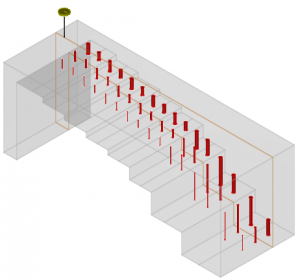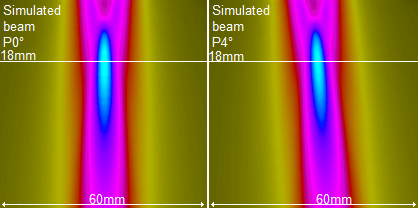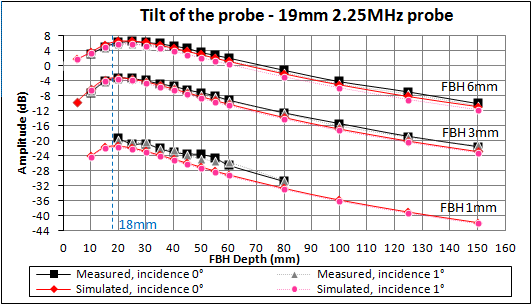UT – FBH: Influence of the tilt of the Probe
As for vertical Flat Bottom Holes (FBH) inspected in P0° mode withe Ø19 mm probes at 2.25 MHz or with Ø12.7 mm probes at 2.25 MHz and at 4.6 MHz, 3 experiments have been carried out with a probe tilted of 0°, 1° and possibly 2° in order to study its influence. The P0°, P1° and P2° waves are respectively refracted into the specimen as P0°, P4° and P8° waves.
CONFIGURATION
The measurements are performed upon a planar steel block containing a series of vertical FBH (Ø:1 mm, 3 mm and 6 mm) at different depths (from 5 mm to 60 mm with a step of 5 mm and then at 80 mm, 100 mm, 125 mm and 150 mm). The specimen and flaws are represented in the following figure.
For each probe a scanning is applied over the surface of the specimen along 2 directions. For each hole, the maximal amplitude of the specular echoes of the FBH is measured relatively to a calibration hole. The interaction model is the Kirchhoff model which is adapted to specular and quasi-specular echoes.
The following immersion probes have been studied with a 50 mm water path:
| Frequency | Crystal | Calibration flaw | Calibration depth |
| 2.0 MHz | Ø19 mm | Ø2 mm FBH | 24 mm |
| 4.6 MHz | Ø12.7 mm | Ø2 mm FBH | 8 mm |
| 5.0 MHz | Ø6.35 mm | Ø2 mm FBH | 24 mm |
RESULTS
Immersion probe 2.0 MHz, Ø19 mm
For the Ø19 mm circular immersion probe at 2 MHz with 50 mm water path, the P0° mode is used for inspection. The input signal frequency is 2.0 MHz, with 60% bandwidth and 0° phase.
The acoustic focusing depth is 18 mm, deduced from the simulated beam illustrated below.
The results are calibrated relatively to a Ø2 mm FBH at 24 mm depth inspected in P0° mode.
There is a good agreement between the results from the measurements and the results from CIVA software. The discrepancy is always less than 2 dB.
Moreover, it can be noticed that the tilt of the probe has no influence on the amplitude of the echoes.
IMMERSION PROBE 4.6 MHz, Ø12.7 mm
For the Ø12.7 mm circular immersion probe at 4.6 MHz with 50 mm water path, the P0° mode is used for inspection. The input signal frequency is 4.6 MHz, with 65% bandwidth and 220° phase.
The acoustic focusing depth is 19 mm, deduced from the simulated beam illustrated below. The focusing depth hardly changes with the tilt.



